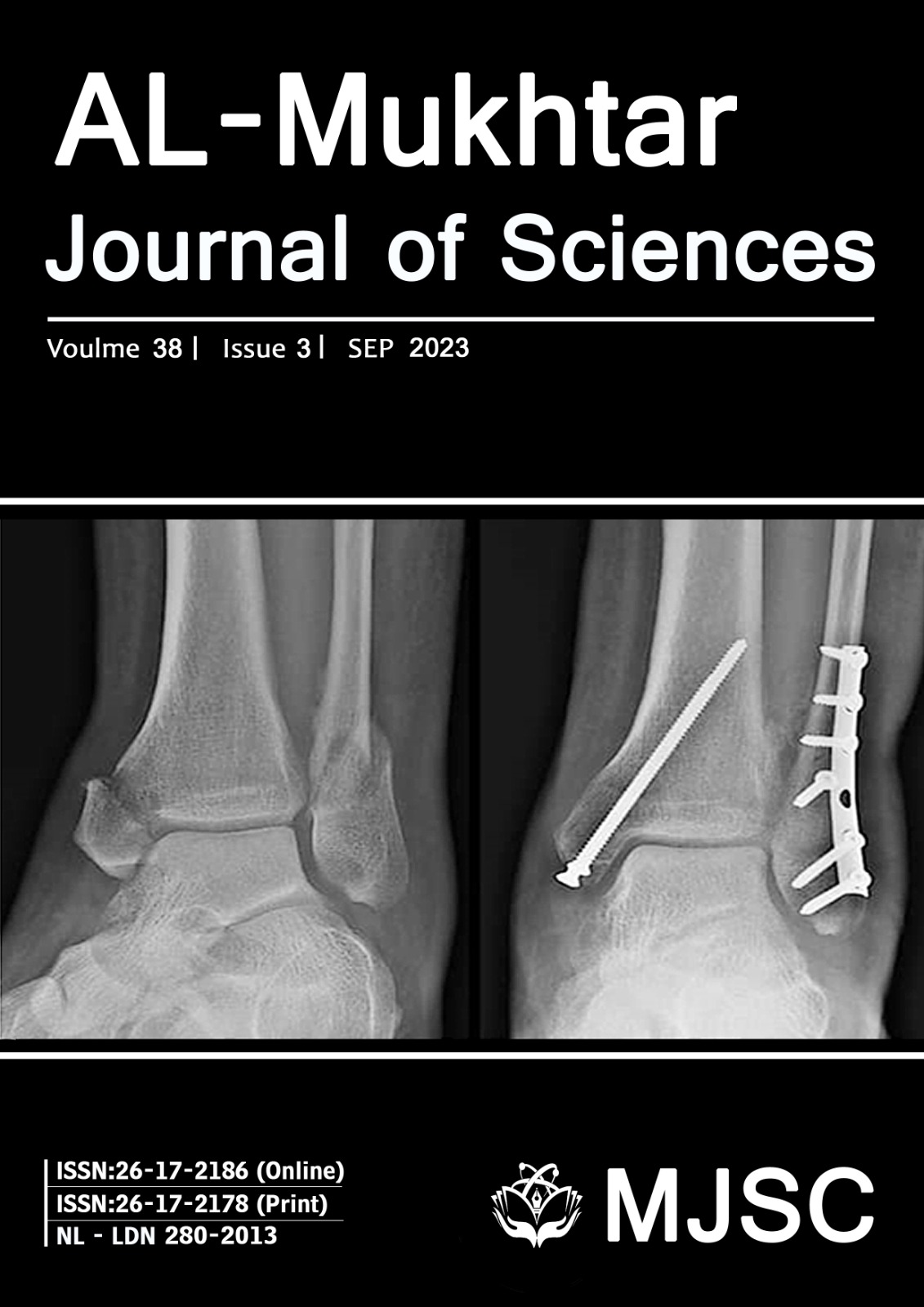Breastfeeding Practices During Neonatal Period in Benghazi
- Authors
-
-
Arwa Gargoum
Department of Pediatrics, Faculty of Medicine, University of Benghazi, LibyaAuthor -
Isaaida A. Elsaeiti
Department of Pediatrics, Faculty of Medicine, University of Benghazi, LibyaAuthor -
Nema Elhouni
Department of Pediatrics, Faculty of Medicine, University of Benghazi, LibyaAuthor
-
- Keywords:
- Exclusive Breastfeeding, Breastfeeding Initiation, Operative Delivery, Maternal Age, Maternal Knowledge
- Abstract
-
Breastfeeding is the safest and healthiest infant feeding method; exclusive breastfeeding for the first 6 months of infant life is strongly advised. This study was conducted to assess infant feeding practice and maternal determinants of infant feeding during the first month of life. In a hospital-based cross-sectional survey at the neonatal unit and OPD of Benghazi Pediatric Hospital, mothers were selected by reason of infant age not exceeding 4 weeks. A sample of 306 mothers was collected, and the alarming results are that about (31.8%) of the mothers are either not breastfeeding their babies or practicing inappropriate early weaning (mixing). Moreover, inadequate milk production (25%) was reported as the most common cause of these practices. In addition, the role of the trustworthy education channel about breastfeeding is minimal, if not there, such as mother and child health care. Also, providers are the source of knowledge for only 2.38%. Operative delivery is associated with a marked delay in breastfeeding initiation (Pearson Chi-square =13.2, P=0.001), and older age group mothers are associated with a greater probability of operative delivery, hence it is an in-direct mediator of delayed breastfeeding initiation. These results reflect poor maternal knowledge and attitude about breastfeeding that ultimately resulted in poor practice and low rate of exclusive breastfeeding, in addition to the limited awareness of healthcare providers about the importance of early initiation of breastfeeding to encourage the mothers and guide them to breastfeed their babies immediately after birth.
- Downloads
-
Download data is not yet available.
- References
-
Al-Hreashy, F. A., Tamim, H. M., Al-Baz, N., Al-Kharji, N. H., Al-Amer, A., Al-Ajmi, H., & Eldemerdash, A. A. (2008). Patterns of breastfeeding practice during the first 6 months of life in Saudi Arabia. Saudi medical journal, 29(3), 427.
Bolton, T. A., Chow, T., Benton, P. A., & Olson, B. H. (2009). Characteristics associated with longer breastfeeding duration: an analysis of a peer counseling support program. Journal of Human Lactation, 25(1), 18-27.
Brown, A., Raynor, P., & Lee, M. (2011). Young mothers who choose to breast feed: the importance of being part of a supportive breast-feeding community. Midwifery, 27(1), 53-59.
Casiday, R. E., Wright, C. M., Panter-Brick, C., & Parkinson, K. N. (2004). Do early infant feeding patterns relate to breast-feeding continuation and weight gain? Data from a longitudinal cohort study. European journal of clinical nutrition, 58(9), 1290-1296.
Damato, E. G., Dowling, D. A., Standing, T. S., & Schuster, S. D. (2005). Explanation for cessation of breastfeeding in mothers of twins. Journal of Human Lactation, 21(3), 296-304.
Donath, S. M., Amir, L. H., & Team, A. S. (2003). Relationship between prenatal infant feeding intention and initiation and duration of breastfeeding: a cohort study. Acta paediatrica, 92(3), 352-356.
Emmanuel, A. (2015). A literature review of the factors that influence breastfeeding: An application of the health belief model.
Februhartanty, J. (2008). Strategic roles of fathers in optimizing breastfeeding practices: a study in an urban setting of Jakarta [dissertation]. Jakarta: Faculty of Medicine University of Indonesia.
Goyal, R. C., Banginwar, A. S., Ziyo, F., & Toweir, A. A. (2011). Breastfeeding practices: positioning, attachment (latch-on) and effective suckling–a hospital-based study in Libya. Journal of Family and Community Medicine, 18(2), 74.
Hayatbakhsh, M. R., O'Callaghan, M. J., Bor, W., Williams, G. M., & Najman, J. M. (2012). Association of breastfeeding and adolescents' psychopathology: a large prospective study. Breastfeeding Medicine, 7(6), 480-486.
Hörnell, A., Lagström, H., Lande, B., & Thorsdottir, I. (2013). Breastfeeding, introduction of other foods and effects on health: a systematic literature review for the 5th Nordic Nutrition Recommendations. Food & nutrition research, 57(1), 20823.
Jebena, D. D., & Tenagashaw, M. W. (2022). Breastfeeding practice and factors associated with exclusive breastfeeding among mothers in Horro District, Ethiopia: A community-based cross-sectional study. PloS one, 17(4), e0267269.
Jones, G., Steketee, R. W., Black, R. E., Bhutta, Z. A., & Morris, S. S. (2003). How many child deaths can we prevent this year? The lancet, 362(9377), 65-71.
Kakute, P. N., Ngum, J., Mitchell, P., Kroll, K. A., Forgwei, G. W., Ngwang, L. K., & Meyer, D. J. (2005). Cultural barriers to exclusive breastfeeding by mothers in a rural area of Cameroon, Africa. Journal of midwifery & women's health, 50(4), 324-328.
Kamal, N. N., Ismael, F. H., Abdelrehim, M. G., & El-Khateeb, A. S. (2021). Breastfeeding practice and perception among women attending Primary Health Care Center in Giza, Egypt. Minia Journal of Medical Research, 32(3), 29-39.
Khassawneh, M., Khader, Y., Amarin, Z., & Alkafajei, A. (2006). Knowledge, attitude and practice of breastfeeding in the north of Jordan: a cross-sectional study. International breastfeeding journal, 1, 1-6.
KNBS, (2010). The 2009 Kenya population and housing census (Vol. 1). Kenya National Bureau of Statistics.
Li, R., Ogden, C., Ballew, C., Gillespie, C., & Grummer-Strawn, L. (2002). Prevalence of exclusive breastfeeding among US infants: the Third National Health and Nutrition Examination Survey (phase II, 1991–1994). American Journal of Public Health, 92(7), 1107-1110.
Martin, R. M., Smith, G. D., Mangtani, P., Frankel, S., & Gunnell, D. (2002). Association between breast feeding and growth: the Boyd-Orr cohort study. Archives of Disease in Childhood-Fetal and Neonatal Edition, 87(3), F193-F201.
Nabulsi, M., Hamadeh, H., Tamim, H., Kabakian, T., Charafeddine, L., Yehya, N., Sinno, D., & Sidani, S. (2014). A complex breastfeeding promotion and support intervention in a developing country: study protocol for a randomized clinical trial. BMC Public Health, 14(1), 1-11.
Nkrumah, J. (2017). Maternal work and exclusive breastfeeding practice: a community based cross-sectional study in Efutu Municipal, Ghana. International breastfeeding journal, 12, 10.
Roberts, T. J., Carnahan, E., & Gakidou, E. (2013). Can breastfeeding promote child health equity? A comprehensive analysis of breastfeeding patterns across the developing world and what we can learn from them. BMC medicine, 11, 1-12.
Stuebe, A. (2009). The risks of not breastfeeding for mothers and infants. Reviews in obstetrics and gynecology, 2(4), 222.
Sutherland, T., Pierce, C. B., Blomquist, J. L., & Handa, V. L. (2011). Breastfeeding Practices Among First-Time Mothers and Across Multiple Pregnancies. Maternal and child health journal, 16(8), 1665-1671.
Victora, C. G., Bahl, R., Barros, A. J., França, G. V., Horton, S., Krasevec, J., Murch, S., Sankar, M. J., Walker, N., & Rollins, N. C. (2016). Breastfeeding in the 21st century: epidemiology, mechanisms, and lifelong effect. The lancet, 387(10017), 475-490.
WHO, G. (2003). Global strategy for infant and young child feeding.
WHO, W. H. O. (2000). Effect of breastfeeding on infant and child mortality due to infectious diseases in less developed countries: a pooled analysis. The lancet, 355(9197), 451-455.
- Downloads
- Published
- 2025-10-13
- Issue
- Vol. 38 No. 3 (2023)
- Section
- Articles
- License
-

This work is licensed under a Creative Commons Attribution-NonCommercial 4.0 International License.
Copyright of the articles Published by Almukhtar Journal of Science (MJSc) is retained by the author(s), who grant MJSc a license to publish the article. Authors also grant any third party the right to use the article freely as long as its integrity is maintained and its original authors and cite MJSc as the original publisher. Also, they accept the article remains published by the MJSc website (except in the occasion of a retraction of the article).
How to Cite
Similar Articles
- Noor E. AL-Attar, Abeer A. Al–Hadidy, The Relationship of Betatrophin and Kisspeptin with Related Hormones in Women Newly Diagnosed with Polycystic Ovary Syndrome , Al-Mukhtar Journal of Sciences: Vol. 38 No. 3 (2023)
- Fathy A. Abdolmejed , The Visual Outcome of Gunshot Injury after Last Civil War in Tobruk-Libya: A Retrospective Study , Al-Mukhtar Journal of Sciences: Vol. 39 No. 2 (2024)
- Haleemah A. Al sheeyab, Hussain Alkhamry, Salem Omaer, Riyad Bendardaf, Cochlear Implant Complications in Children: Libyan Scenario and Experience , Al-Mukhtar Journal of Sciences: Vol. 39 No. 1 (2024)
- Khaled Faiz, Jamal Gomati, Tariq Elhoony, Tariq Aldarat, Salah Eltaktouk, Muftah Elkhafifi, Ali Abokiash, Raouf Kwafi, Issa Abuzied, Iliopsoas Abscess: Presentation, Etiology, Treatment Options, and Outcomes: A Retrospective Analysis of 19 Cases , Al-Mukhtar Journal of Sciences: Vol. 40 No. 1 (2025)
- Nasren G. S. Alfraik, Amera M. Mohmed, Aya S. Balhouq, Doaa F. Salih, Rajaa J. Saleh, Sana B. Aqoub, Obesogenic Factors in School-Aged Children in Tobruk City, Libya , Al-Mukhtar Journal of Sciences: Vol. 40 No. 1 (2025)
- Muftah H. Elkhafifi, Abdulsalam A. Nabous, Ali T. Muftah, Giant Vesical Calculus Presented with Anuria in a Young Male Patient: A Case Report , Al-Mukhtar Journal of Sciences: Vol. 39 No. 3 (2024)
- Taher I. Shailabi, Nisreen Saed Majeed, Elham O. Borwis, Nagat H. Bubtina, Non-Compliance of Patients with Antibiotic Prescriptions , Al-Mukhtar Journal of Sciences: Vol. 38 No. 3 (2023)
- Kaula. A. Saad, Hanan. A. Ageehal, Ahmed. S. Elgrari, An Epidemiological Study of Cutaneous Leishmaniasis in the Cities of Sirte and Jadu, Libya: During 2019-2020 , Al-Mukhtar Journal of Sciences: Vol. 40 No. 1 (2025)
- Suliman M. AL-Nashad, Hana A. Shaheen, Prevalence of Amiodarone induced vortex keratopathy at Benghazi National Cardiac Centre , Al-Mukhtar Journal of Sciences: Vol. 39 No. 2 (2024)
- Yosef Hassan. S. Abdulkarim, Hajer M. M Farkash, Khaled G Hasen, Clinical manifestations of gastro esophageal reflux among patients with chronic laryngitis in Benghazi, 2018 , Al-Mukhtar Journal of Sciences: Vol. 39 No. 1 (2024)
You may also start an advanced similarity search for this article.

















